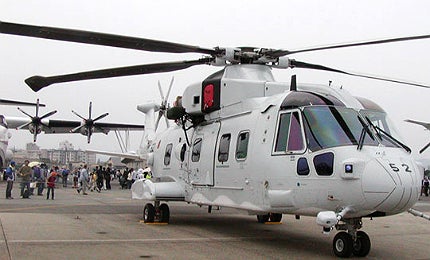MCH-101 is an Airborne Mine Countermeasures (AMCM) and transport helicopter, operated by the Japan Maritime Self Defence Force (JMSDF). Modified by Kawasaki Heavy Industries (KHI), MCH-101 was derived from the EH-101 medium lift helicopter, manufactured by AgustaWestland. The MCH-101 will replace the fleet of MH-53E that are in service with the JMSDF.
The MCH-101 helicopters are primarily deployed in minesweeping and transport missions. It will also be used to provide transport support for Antarctic exploration. The MCH-101 can be operated from shore as well as from JMSDF ships, such as Hyuga Class helicopter destroyers.
AMCM helicopter development
KHI was selected as a prime contractor by the Japan Defence Agency (JDA) in 2003 to produce the airframe and engine of EH-101. KHI signed an agreement with AgustaWestland to produce MCH-101 minesweeping helicopters based on the EH-101. KHI was awarded contracts to supply a total of 14 helicopters for the JMSDF.
The first MCH-101 AMCM helicopter was assembled by AgustaWestland. The helicopter made its first flight in February 2005. It was delivered to the JDA in March 2006. The second MCH-101 helicopter, built by Kawasaki under license, was handed over to the JMSDF in March 2007.
In June 2009, AgustaWestland signed a contract with Marubeni Aerospace to establish a new spare parts depot to support the MCH-101 and CH-101 helicopters of the JMSDF.
MCH-101 design, cockpit and avionics
Based on the EH-101, the MCH-101 helicopter was designed to meet the minesweeping requirements of the JMSDF. The modular airframe of the MCH-101 is made of aluminium alloy and composite materials. The spacious cabin provides an enhanced transport capacity for increased operational efficiency. It allows the integration of crash-worthy seats for accommodating up to 36 troops. The rear ramp opening ensures the loading of cargo and passengers.
The power plant with three engines drives the high-performance five-bladed main rotor. The rotor blades and tail section can be folded for convenient stowage on the warships. The helicopter is also equipped with an active anti-vibration system. The helicopter features superior flying characteristics, while offering higher safety levels.
The length of the MCH-101 is 22.8m, while the rotor diameter and height of the helicopter are 18.6m and 6.6m respectively. The helicopter has the gross weight of 14,800kg.
The glass cockpit of MCH-101 accommodates two crew members, including a pilot and co-pilot. The night vision goggle (NVG) compatible cockpit is equipped with five multiconfigurable liquid crystal displays.
The avionics suite integrates two multifunction control and display units, dual automatic flight control system, communication and navigation suite, search or weather radar, surveillance radar and obstacle warning system.
Countermeasures of the Japanese helicopters
The mine countermeasures systems of MCH-101 helicopter are the AN/AQS-24A airborne minehunting system, the AN/AES-1 Airborne Laser Mine Detection System (ALMDS) and the MK 104 acoustic minesweeping device.
In July 2012, Northrop Grumman received a series of follow-on contracts from the JMSDF to supply three more AQS-24A systems. Northrop Grumman was initially contracted to supply the first AQS-24A system in October 2011. The AQS-24A is a high speed mine-hunting system towed from the helicopter. It includes a laser line scanner for discovering underwater mines and other targets of interest.
In November 2012, Science Applications International Corporation (SAIC) was awarded a contract by the JMSDF to deliver the Mine Warfare and Environmental Decision Aids Library (MEDAL) software system. MEDAL is incorporated into the ground support system of MCH-101. It will complement the mission planning, evaluation and command and control of mine countermeasure missions. The MEDAL system also allows the JMSDF to interoperate with the US Navy.
MCH-101 AMCM helicopter engine details
The MCH-101 helicopter is powered by three Rolls-Royce Turbomeca RTM322 turboshaft engines. KHI was granted a licence to assemble, test, repair and overhaul RTM322 engines for the MCH-101 fleet of the JMSDF. The first engine assembled by KHI was delivered to the JMSDF in 2005.
Each RTM322 engine develops a maximum power of 1,566 kW. The engine’s operation is controlled by a Full Authority Digital Engine Control (FADEC) system. The power plant provides a maximum speed of 280km/h.
The Global Military Rotorcraft Market 2011-2021
This project forms part of our recent analysis and forecasts of the global military rotorcraft market available from our business information platform Strategic Defence Intelligence. For more information click here or contact us: EMEA: +44 20 7936 6783; Americas: +1 415 439 4914; Asia Pacific: +61 2 9947 9709 or via email.
Related content
JMSDF Hyuga Class Destroyer, Japan
Hyuga Class helicopter destroyers are in service with the Japanese Maritime Self Defence Force (JMSDF). IHI Marine United custom built two Hyuga Class ships at the Yokohama shipyard, for the JMSDF.
Shirane Class Helicopter Destroyers (JMSDF), Japan
Shirane Class helicopter destroyers are in service with the Japan Maritime Self-Defense Force. Two destroyers built by the Ishikawajima-Harima Heavy Industries (now IHI Corporation) replaced the Haruna Class destroyers.







